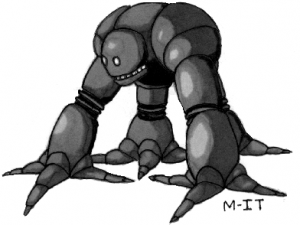
When I started play testing The Artifact RPG, some of its inspiration came from the movie Lawrence of Arabia. While the movie doesn’t center around survival, the crossing of the Nefud Desert is a great part of the movie. I wanted to make survival situations an interesting part of our games. I thought that story telling would be enough to use it to add flavor to the game. I was wrong and it almost universally backfired. Crossing a dessert is boring and there really is only one choice for the players “I keep going”. Rolls to test their will or endurance can only lead to eventual failure and are therefore despised.
Most other survival situations are met with similar reactions. The GM can describe the situation beautifully and compellingly but the players have only one option, keep going. So they disengage, their eyes glaze over and the game is lost.
Is It Hopeless?
I thought it was for a while. I’ve been thinking about it recently and now I’m ready to try again. My main thought is to take what is known to work in an RPG (combat) and use that as a model to make survival tasks interesting. Let’s look at the basic monster encounter. What makes it interesting? There’s something to defeat, maybe the PC get experience for it, the players get to test their characters and equipment. Some games also have the monster drop treasure, I’ve never played that way so it’s not a factor in my imagination but if you want the PCs to get gold for climbing a mountain, it makes as much sense as a giant lizard dropping money. Keep in mind, defeating a monster is not usually the purpose of the players (okay maybe it is for some) it is more likely that there is a goal somewhere beyond the monster and the same should be true for these obstacles. Another thing that makes a monster interesting is that the player’s rolls bring them closer to winning instead of just staving off failure.
So what does a monster have? They have hit points, they have attacks against the characters and they have defenses. Let’s give that to a dessert or a mountain, they need to be tweaked a bit first though.
Instead of hit points I’m going to give these obstacles Surmount Points (sounds weird to me, maybe Surmount Value? Let me know if you have a better name in the comments). Each successful roll will bring down the SP of the obstacle. The types of rolls would vary based on the type of obstacle.
Next the obstacle needs to have attacks. Each turn the players roll to surmount the obstacle it gets to fight back. In reality the obstacle is just existing and the characters are just experiencing it but the idea still makes sense. There is one caveat to this, the obstacle should not hit the players as hard as possible every time. In fact, most of it’s attacks should be easily weathered by the players. Major danger should only happen occasionally because the obstacle has no guiding intelligence (although in some games it could which is interesting in itself). Because of this the attacks should happen randomly.
Lastly the obstacle needs defenses. This consists mainly of things the players cannot do to defeat the obstacle. Some cliff walls may be unclimbable without a rope because they’re made of shale or very sheer rock. The PC cannot wait out a dessert (actually maybe you could, some have a rainy season). These will be very individual to each obstacle. The defenses could also have weaknesses (like the afore-mentioned rainy season) that a knowledgeable character could exploit.
The Take Down
So how does a character surmount an obstacle? Most of them are basic and any human of good health could attempt to surmount them. Special knowledge of the obstacle or survival techniques help a lot but should not be a prerequisite. Because of this base stats should usually be cited for resolution.
I’m going to also strongly suggest a system of success by degrees. I use this in The Artifact RPG system and I feel it will make this process far more enjoyable but it is possible to implement in most systems. Put simply there is a base success and a series of more difficult to achieve successes with the pay off for each increasing with the value of the success.
Here’s where things get a little weird. All characters have to defeat the obstacle individually. Here you can’t have the one guy that defeats the monster and everyone else gives a little support. In a sense each character has their own obstacle to defeat. However characters can help each other get past the obstacle so if one character fails his rolls and another character does exceptionally well, he can share up to half his SP for that turn with the other player.
Example Obstacle
I’m going to be using The Artifact’s system to set this obstacle up but I’ll include general notes to convert the effects to another system. I’m not super sure of the numbers here.
Desert
This region of very low precipitation leaves little in the way of drinking water and very little grows here so there is no food. Harsh conditions await anyone attempting to cross it.
Surmount Method: Carrying water and food to get across. Foraging while in the desert. Fast travel.
Surmounting Attribute: Constitution (or endurance)
SP 1 per 5 Kilometers (usually more than 300 Km or 20 SP)
Hazards
Dehydration
For every survival round the characters face a dehydration hazard that can only be defended against by drinking 1 liter of water. If the character does not drink the required amount they get a -2 CDF to Con (or 5-6% of their endurance attribute). CDF penalties accumulate until the characters can eat, drink and recover for a period of time. If the CDF penalties exceed their Con the character takes one point of damage per round.
Exertion
For every survival round the characters face an exertion hazard. While walking on foot the character has to exert themselves this leads to further dehydration they get a -2 CDF to Con (or 5-6% of their endurance attribute) unless they drink another liter of water or making a successful Con roll. CDF penalties accumulate until the characters can eat, drink and recover for a period of time. If the CDF penalties exceed their Con the character takes one point of damage per round.
Random Hazard
For every survival round the GM should roll once on the following table.
Roll 1D100
| 1-70 |
Blazing sun |
| 71-75 |
Frigid night |
| 76-85 |
Monotony |
| 86-90 |
Ravine |
| 91-95 |
Lost |
| 96-98 |
Sand/dust storm |
| 99 |
Sink hole |
| 100 |
Oasis |
Blazing sun
The heat is especially intense, the characters face an extra dehydration hazard this leads to further dehydration they get a -2 CDF to Con (or 5-6% of their endurance attribute) unless they drink another liter of water or making a successful Con roll.
Frigid night
The night is very cold. Without warm cloths or a fire the characters get a -10 to their Con.
Monotony
The boredom is getting to the characters, they must make a successful Psy roll or they cannot travel.
Ravine
A deep gorge blocks travel. Going around will take a trip of 30 Km. (Climbing down and back up the ravine would require a Ravine Hazard be made).
Lost
The characters have lost their direction for some time and didn’t notice it. Roll 2D6 and add that to the remaining SP.
Sand/dust Storm
A fierce storm blocks travel for a day and gives the following CDFs -10 Con, -5 Str, -2 Ref unless the characters are able to find or erect a shelter.
Salt Marsh
A salt marsh appears like an oasis but a telltale line of white salt surrounds the marsh. The water will taste salty which may warn the characters not to drink it. If the characters have lost Hit Points due to dehydration they must make a Psy roll to resist drinking the water.
Sink Hole
A sink hole opens up and swallows one character. They cannot get out by themselves but can be pulled out with rope or a human chain.
Oasis
The characters can drink as much water as they need and can refill their water supply.
Defenses and Weaknesses
Weakness: Rainy season 25% chance
There is a rainy season that makes 1D100% of the desert easily passable. The characters have to wait 2D6 months for the season to come.
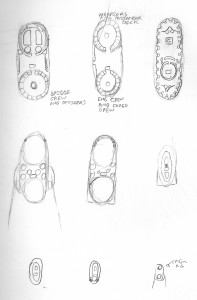 You want to game? Right now? Okay give me ten minutes and I’ll have a game for you.
You want to game? Right now? Okay give me ten minutes and I’ll have a game for you.

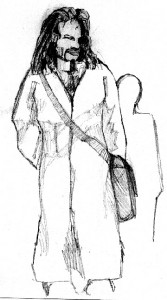
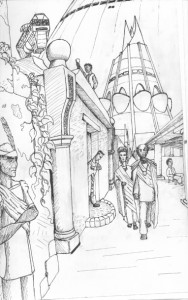
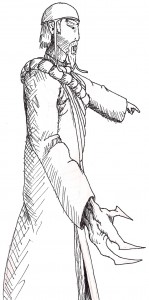


 The Free RPG Blog
The Free RPG Blog